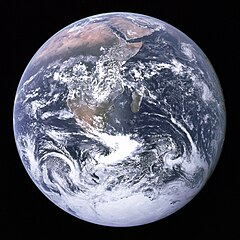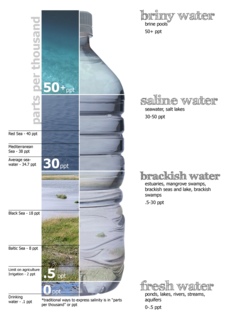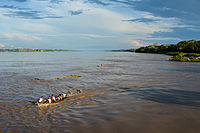Fresh water: Difference between revisions
ClueBot NG (talk | contribs) m Reverting possible vandalism by 24.43.186.25 to version by Level C. Report False Positive? Thanks, ClueBot NG. (3122817) (Bot) |
Rescuing 2 sources and tagging 0 as dead. #IABot (v1.5.5) |
||
| Line 37: | Line 37: | ||
== Numerical definition == |
== Numerical definition == |
||
Fresh water can be defined as water with less than 500 [[parts per million]] (ppm) of dissolved [[salt]]s.<ref>{{cite web | url=http://www.groundwater.org/gi/gwglossary.html#F | title=Groundwater Glossary | date=27 March 2006 | accessdate=14 May 2006 | deadurl= |
Fresh water can be defined as water with less than 500 [[parts per million]] (ppm) of dissolved [[salt]]s.<ref>{{cite web | url=http://www.groundwater.org/gi/gwglossary.html#F | title=Groundwater Glossary | date=27 March 2006 | accessdate=14 May 2006 | deadurl=yes | archiveurl=https://web.archive.org/web/20060428102341/http://www.groundwater.org/gi/gwglossary.html#F | archivedate=28 April 2006 | df=dmy-all }}</ref> |
||
{{Water salinity}} |
{{Water salinity}} |
||
Other sources give higher upper salinity limits for fresh water, e.g. 1000 ppm<ref>{{cite web |
Other sources give higher upper salinity limits for fresh water, e.g. 1000 ppm<ref>{{cite web |
||
|title = Freshwater |
|||
|work = Glossary of Meteorology |
|||
|publisher = [[American Meteorological Society]] |
|||
|date = June 2000 |
|||
|url = http://amsglossary.allenpress.com/glossary/search?p=1&query=freshwater |
|||
|accessdate = 27 November 2009 |
|||
|deadurl = yes |
|||
|archiveurl = https://web.archive.org/web/20110606104533/http://amsglossary.allenpress.com/glossary/search?p=1&query=freshwater |
|||
|archivedate = 6 June 2011 |
|||
|df = dmy-all |
|||
}}</ref> |
|||
or 3000 ppm.<ref>{{cite web|title=Freshwater |work=Fishkeeping glossary |publisher=[[Practical Fishkeeping]] |url=http://www.practicalfishkeeping.co.uk/pfk/pages/glossary.php?entry_name=Freshwater |accessdate=27 November 2009 |deadurl=yes |archiveurl=https://web.archive.org/web/20060511182717/http://www.practicalfishkeeping.co.uk/pfk/pages/glossary.php?entry_name=Freshwater |archivedate=11 May 2006 }}</ref> |
or 3000 ppm.<ref>{{cite web|title=Freshwater |work=Fishkeeping glossary |publisher=[[Practical Fishkeeping]] |url=http://www.practicalfishkeeping.co.uk/pfk/pages/glossary.php?entry_name=Freshwater |accessdate=27 November 2009 |deadurl=yes |archiveurl=https://web.archive.org/web/20060511182717/http://www.practicalfishkeeping.co.uk/pfk/pages/glossary.php?entry_name=Freshwater |archivedate=11 May 2006 }}</ref> |
||
Revision as of 00:23, 8 October 2017

Fresh water is naturally occurring water on Earth's surface in ice sheets, ice caps, glaciers, icebergs, bogs, ponds, lakes, rivers and streams, and underground as groundwater in aquifers and underground streams. Fresh water is generally characterized by having low concentrations of dissolved salts and other total dissolved solids. The term specifically excludes seawater and brackish water although it does include mineral-rich waters such as chalybeate springs. The term "sweet water" (from Spanish "agua dulce") has been used to describe fresh water in contrast to salt water. The term "fresh water" does not have the same meaning as potable water. Much of the surface fresh water and ground water is unsuitable for drinking without some form of purification because of the presence of chemical or biological contaminants.
Systems
Fresh water habitats are divided into lentic systems, which are the stillwaters including ponds, lakes, swamps and mires; lotic, or running-water systems; and groundwater which flows in rocks and aquifers. There is, in addition, a zone which bridges between groundwater and lotic systems, which is the hyporheic zone, which underlies many larger rivers and can contain substantially more water than is seen in the open channel. It may also be in direct contact with the underlying underground water. The majority of fresh water on Earth is in ice caps.
Sources
The source of almost all fresh water is precipitation from the atmosphere, in the form of mist, rain and snow. Fresh water falling as mist, rain or snow contains materials dissolved from the atmosphere and material from the sea and land over which the rain bearing clouds have traveled. In industrialized areas rain is typically acidic because of dissolved oxides of sulfur and nitrogen formed from burning of fossil fuels in cars, factories, trains and aircraft and from the atmospheric emissions of industry. In some cases this acid rain results in pollution of lakes and rivers.
In coastal areas fresh water may contain significant concentrations of salts derived from the sea if windy conditions have lifted drops of seawater into the rain-bearing clouds. This can give rise to elevated concentrations of sodium, chloride, magnesium and sulfate as well as many other compounds in smaller concentrations.
In desert areas, or areas with impoverished or dusty soils, rain-bearing winds can pick up sand and dust and this can be deposited elsewhere in precipitation and causing the freshwater flow to be measurably contaminated both by insoluble solids but also by the soluble components of those soils. Significant quantities of iron may be transported in this way including the well-documented transfer of iron-rich rainfall falling in Brazil derived from sand-storms in the Sahara in north Africa.
Water distribution

Water is a critical issue for the survival of all living organisms. Some can use salt water but many organisms including the great majority of higher plants and most mammals must have access to fresh water to live. Some terrestrial mammals, especially desert rodents appear to survive without drinking but they do generate water through the metabolism of cereal seeds and they also have mechanisms to conserve water to the maximum degree.
Out of all the water on Earth, saline water in oceans, seas and saline groundwater make up about 97% of it. Only 2.5–2.75% is fresh water, including 1.75–2% frozen in glaciers, ice and snow, 0.5–0.75% as fresh groundwater and soil moisture, and less than 0.01% of it as surface water in lakes, swamps and rivers.[2][3] Freshwater lakes contain about 87% of this fresh surface water, including 29% in the African Great Lakes, 22% in Lake Baikal in Russia, 21% in the North American Great Lakes, and 14% in other lakes. Swamps have most of the balance with only a small amount in rivers, most notably the Amazon River. The atmosphere contains 0.04% water.[4] In areas with no fresh water on the ground surface, fresh water derived from precipitation may, because of its lower density, overlie saline ground water in lenses or layers. Most of the world's fresh water is frozen in ice sheets. Many areas suffer from lack of distribution of fresh water, such as deserts.
Numerical definition
Fresh water can be defined as water with less than 500 parts per million (ppm) of dissolved salts.[5]
| Part of a series on |
| Water salinity |
|---|
 |
| Salinity levels |
|
Fresh water (< 0.05%) Brackish water (0.05–3%) Saline water (3–5%) Brine (> 5% up to 26%–28% max) |
| Bodies of water |
Other sources give higher upper salinity limits for fresh water, e.g. 1000 ppm[6] or 3000 ppm.[7]
Aquatic organisms
Fresh water creates a hypotonic environment for aquatic organisms. This is problematic for some organisms with pervious skins or with gill membranes, whose cell membranes may burst if excess water is not excreted. Some protists accomplish this using contractile vacuoles, while freshwater fish excrete excess water via the kidney.[8] Although most aquatic organisms have a limited ability to regulate their osmotic balance and therefore can only live within a narrow range of salinity, diadromous fish have the ability to migrate between fresh water and saline water bodies. During these migrations they undergo changes to adapt to the surroundings of the changed salinities; these processes are hormonally controlled. The eel (Anguilla anguilla) uses the hormone prolactin,[9] while in salmon (Salmo salar) the hormone cortisol plays a key role during this process.[10]
Many sea birds have special glands at the base of the bill through which excess salt is excreted. Similarly the marine iguanas on the Galápagos Islands excrete excess salt through a nasal gland and they sneeze out a very salty excretion.
Fresh water as a resource

An important concern for hydrological ecosystems is securing minimum streamflow, especially preserving and restoring instream water allocations.[11] Fresh water is an important natural resource necessary for the survival of all ecosystems. The use of water by humans for activities such as irrigation and industrial applications can have adverse impacts on down-stream ecosystems. Chemical contamination of fresh water can also seriously damage eco-systems.
Pollution from human activity, including oil spills and also presents a problem for freshwater resources. The largest petroleum spill that has ever occurred in fresh water was caused by a Royal Dutch Shell tank ship in Magdalena, Argentina, on 15 January 1999, polluting the environment, drinkable water, plants and animals.[12]
Fresh and unpolluted water accounts for 0.003% of total water available globally.[13]
Agriculture
Changing landscape for the use of agriculture has a great effect on the flow of fresh water. Changes in landscape by the removal of trees and soils changes the flow of fresh water in the local environment and also affects the cycle of fresh water. As a result, more fresh water is stored in the soil which benefits agriculture. However, since agriculture is the human activity that consumes the most fresh water,[14] this can put a severe strain on local freshwater resources resulting in the destruction of local ecosystems. In Australia, over-abstraction of fresh water for intensive irrigation activities has caused 33% of the land area to be at risk of salination.[14] With regards to agriculture, the World Bank targets food production and water management as an increasingly global issue that will foster debate.[15]
Limited resource
Fresh water is a renewable and variable, but finite natural resource. Fresh water can only be replenished through the process of the water cycle, in which water from seas, lakes, forests, land, rivers, and reservoirs evaporates, forms clouds, and returns as precipitation. Locally however, if more fresh water is consumed through human activities than is naturally restored, this may result in reduced fresh water availability from surface and underground sources and can cause serious damage to surrounding and associated environments.
Fresh water withdrawal
Fresh water withdrawal is the quantity of water removed from available sources for use in any purpose, excluding evaporation losses. Water drawn off is not necessarily entirely consumed and some portion may be returned for further use downstream.
Causes of limited fresh water
The increase in the world population and the increase in per capita water use puts increasing strains on the finite resources avialability of clean fresh water The World Bank adds that the response by freshwater ecosystems to a changing climate can be described in terms of three interrelated components: water quality, water quantity or volume, and water timing. A change in one often leads to shifts in the others as well.[16] Water pollution and subsequent eutrophication also reduces the availability of fresh water.[17]
Fresh water in the future
Many areas of the world are already experiencing stress on water availability. Due to the accelerated pace of population growth and an increase in the amount of water a single person uses, it is expected that this situation will continue to get worse. A shortage of water in the future would be detrimental to the human population as it would affect everything from sanitation, to overall health and the production of grain.[18]
Choices in the use of fresh water
With one in eight people in the world not having access to safe water[19] it is important to use this resource in a prudent manner. Making the best use of water on a local basis probably provides the best solution. Local communities need to plan their use of fresh water and should be made aware of how certain crops and animals use water.
As a guide the following tables provide some indicators.
Table 1 Recommended basic water requirements for human needs (per person) [20]
| Activity | Minimum, litres / day | Range / day |
|---|---|---|
| Drinking Water | 5 | 2–5 |
| Sanitation Services | 20 | 20–75 |
| Bathing | 15 | 5–70 |
| Cooking and Kitchen | 10 | 10–50 |
Table 2. Water Requirements of different classes of livestock [21]
| Animal | Average / day | Range / day |
|---|---|---|
| Dairy cow | 76 L (20 US gal) | 57 to 95 L (15 to 25 US gal) |
| Cow-calf pair | 57 L (15 US gal) | 8 to 76 L (2 to 20 US gal) |
| Yearling cattle | 38 L (10 US gal) | 23 to 53 L (6 to 14 US gal) |
| Horse | 38 L (10 US gal) | 30 to 53 L (8 to 14 US gal) |
| Sheep | 8 L (2 US gal) | 8 to 11 L (2 to 3 US gal) |
Table 3 Approximate values of seasonal crop water needs [22]
| Crop | Crop water needs mm / total growing period |
|---|---|
| Banana | 1200–2200 |
| Barley/Oats/Wheat | 450–650 |
| Cabbage | 350–500 |
| Citrus | 900–1200 |
| Onions | 350–550 |
| Pea | 350–500 |
| Potato | 500–700 |
| Sugar Cane | 1500–2500 |
| Tomato | 400–800 |
See also
- African Great Lakes
- Aral Sea
- Desalination
- Drinking water
- Drought
- Freshwater ecology
- Great Lakes
- Lake Baikal
- Lake
- Limnology
- List of countries by freshwater withdrawal
- List of countries by total renewable water resources
- Properties of water
- River
- Seawater
- Water crisis
- Water cycle
- Water resources
- Water well
References
- ^ USGS – Earth's water distribution Archived 29 June 2012 at the Wayback Machine. Ga.water.usgs.gov (11 December 2012). Retrieved on 29 December 2012.
- ^ Where is Earth's water? Archived 14 December 2013 at the Wayback Machine, United States Geological Survey.
- ^ Physicalgeography.net Archived 26 January 2016 at the Wayback Machine. Physicalgeography.net. Retrieved on 29 December 2012.
- ^ Gleick, Peter; et al. (1996). Stephen H. Schneider (ed.). Encyclopedia of Climate and Weather. Oxford University Press.
- ^ "Groundwater Glossary". 27 March 2006. Archived from the original on 28 April 2006. Retrieved 14 May 2006.
{{cite web}}: Unknown parameter|deadurl=ignored (|url-status=suggested) (help) - ^ "Freshwater". Glossary of Meteorology. American Meteorological Society. June 2000. Archived from the original on 6 June 2011. Retrieved 27 November 2009.
{{cite web}}: Unknown parameter|deadurl=ignored (|url-status=suggested) (help) - ^ "Freshwater". Fishkeeping glossary. Practical Fishkeeping. Archived from the original on 11 May 2006. Retrieved 27 November 2009.
{{cite web}}: Unknown parameter|deadurl=ignored (|url-status=suggested) (help) - ^ "Vertebrate Kidneys". 3 November 2002. Archived from the original on 29 April 2006. Retrieved 14 May 2006.
{{cite web}}: Unknown parameter|deadurl=ignored (|url-status=suggested) (help) - ^ Kalujnaia, S.; et al. (2007). "Salinity adaptation and gene profiling analysis in the European eel (Anguilla anguilla) using microarray technology". Gen Comp Endocrinol. 152 (2007). National Center for Biotechnology Information: 274–80. doi:10.1016/j.ygcen.2006.12.025. PMID 17324422.
{{cite journal}}: Explicit use of et al. in:|author2=(help) - ^ Bisal, G.A.; Specker, J.L. (24 January 2006). "Cortisol stimulates hypo-osmoregulatory ability in Atlantic salmon, Salmo salar L". Journal of Fish biology. 39 (3). Wiley: 421–432. doi:10.1111/j.1095-8649.1991.tb04373.x.
- ^ Peter Gleick; Heather Cooley; David Katz (2006). The world's water, 2006–2007: the biennial report on freshwater resources. Island Press. pp. 29–31. ISBN 1-59726-106-8. Retrieved 12 September 2009.
- ^ Petroleomagdalena.com Archived 14 May 2010 at the Wayback Machine. Petroleomagdalena.com (15 January 1999). Retrieved on 29 December 2012.
- ^ Nitti, Gianfranco (May 2011). "Water is not an infinite resource and the world is thirsty". The Italian Insider. Rome. p. 8.
- ^ a b Gordon L., D. M. (2003). "Land cover change and water vapour flows: learning from Australia". Philosophical Transactions of the Royal Society B: Biological Sciences. 358 (1440): 1973–1984. doi:10.1098/rstb.2003.1381. JSTOR 3558315. PMC 1693281. PMID 14728792.
- ^ Reengaging in Agricultural Water Management: Challenges and Options, The World Bank, pp. 4–5, archived from the original on 5 January 2012, retrieved 30 October 2011
{{citation}}: Unknown parameter|deadurl=ignored (|url-status=suggested) (help) - ^ The World Bank, 2009 "Water and Climate Change: Understanding the Risks and Making Climate-Smart Investment Decisions". pp. 19–22. Archived from the original on 7 April 2012. Retrieved 24 October 2011.
{{cite web}}: Unknown parameter|deadurl=ignored (|url-status=suggested) (help) - ^ "Nutrients in fresh water"
- ^ "Fresh Water in the Future" Archived 30 December 2016 at the Wayback Machine. Un.org (17 December 2010). Retrieved on 29 December 2012.
- ^ Water Aid. "Water". Retrieved 17 March 2012.
- ^ Gleick, Peter. "Basic Water Requirements for Human Activities" (PDF). Archived from the original (PDF) on 29 June 2013. Retrieved 17 March 2012.
{{cite web}}: Unknown parameter|deadurl=ignored (|url-status=suggested) (help) - ^ Filley, S. "How much does a cow need ?" (PDF). Archived from the original (PDF) on 12 May 2012. Retrieved 17 March 2012.
{{cite web}}: Unknown parameter|deadurl=ignored (|url-status=suggested) (help) - ^ Natural Resource Management and Environmental Dept. "Crops Need Water". Archived from the original on 16 January 2012. Retrieved 17 March 2012.
{{cite web}}: Unknown parameter|deadurl=ignored (|url-status=suggested) (help)
Further reading
- Jackson, Robert B.; Carpenter, Stephen R.; Dahm, Clifford N.; McKnight, Diane M.; Naiman, Robert J.; Postel, Sandra L.; Running, Steven W. (2001). "Water in a changing world". Ecological Applications. 11 (4): 1027–1045. doi:10.1890/1051-0761(2001)011[1027:wiacw]2.0.co;2.
- Moustakas, A.; Karakassis, I. "How diverse is aquatic biodiversity research?". Aquatic Ecology. 39: 367–375. doi:10.1007/s10452-005-6041-y.
- Richter, Brian D.; Mathews, Ruth; Harrison, David L.; Wigington, Robert (2003). "Ecologically sustainable water management: managing river flows for ecological integrity". Ecological Applications. 13 (1): 206–224. doi:10.1890/1051-0761(2003)013[0206:eswmmr]2.0.co;2.
External links
- The World Bank's work and publications on water resources
- World Bank report on Agricultural water management
- FBA.org.uk, Freshwater Biological Association
- Review of freshwater ecology in the UK
- Environment-agency.gov.uk UK Environment Agency website
- Pondconservation.org.uk
- UK National pond monitoring network
- U.S. Geological Survey
- Fresh Water National Geographic
- Safe and Sustainable Water for Haiti web site hosted by Grand Valley State University



